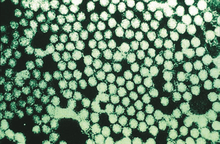Aphthovirus
Aphthovirus (from the Greek aphtha-, vesicles in the mouth) is a viral genus of the family Picornaviridae. Aphthoviruses infect vertebrates, and include the causative agent of foot-and-mouth disease. Foot-and-mouth disease virus (FMDV) is the prototypic member of the genus Aphthovirus.[1] There are seven FMDV serotypes: A, O, C, SAT 1, SAT 2, SAT 3 and Asia 1, and four non-FMDV serotypes belonging to three additional species Bovine rhinitis A virus (BRAV), Bovine rhinitis B virus (BRBV) and Equine rhinitis A virus (ERAV).
| Aphthovirus | |
|---|---|
 | |
| Electronmicrograph of Foot-and-mouth disease virus | |
| Virus classification | |
| (unranked): | Virus |
| Realm: | Riboviria |
| Phylum: | incertae sedis |
| Order: | Picornavirales |
| Family: | Picornaviridae |
| Genus: | Aphthovirus |
| Type species | |
| Foot-and-mouth disease virus | |
| Species | |
| |
Morphology and genome structure
Aphthoviruses are non-enveloped and have an icosahedral nucleocapsid with a diameter of around 27 to 30 nm. The aphthoviruses are differentiated from other picornaviruses as they have a larger genome (ca. 8.2 kilobases). The genome is linear and non-segmented. It consists of a single molecule of (+) sense RNA, with a 5' genome linked protein (VPg), which is associated to the genome via a phosphodiester bond linked to a tyrosine residue. The 5' end of the genome contains a poly(C) tract, while the 3' end is polyadenylated.[2]
The virions consist of a non-enveloped virus capsid, which is round and displays icosahedral symmetry.
| Genus | Structure | Symmetry | Capsid | Genomic arrangement | Genomic segmentation |
|---|---|---|---|---|---|
| Aphthovirus | Icosahedral | Pseudo T=3 | Non-enveloped | Linear | Monopartite |
Replication, ecology and pathology
Aphthoviruses replicate in a similar fashion to all picornaviruses. Replication is cytoplasmic and initially involves attachment of the exogenous virus to the cell membrane. Attachment to the membrane and subsequent entry into the cell is mediated by a membrane receptor. After genome replication within the cytoplasm, virion assembly occurs and new virus particles aggregate within the cell. Release of virus particles is mediated by cell lysis.
Aphthoviruses include the causative agents of foot-and-mouth disease (FMD), which primarily affects livestock such as cattle, swine, sheep and goats. FMD was first discovered in Italy in the 16th century. Since then, the prevalence of the disease has remained, despite many countries being declared FMD-free. Endemic regions of the disease include areas of Europe, Asia and South America. The virus commonly persists in animal feed and is able to survive environmentally for up to one month. Eradication of FMD in endemic areas has been difficult, despite the availability of a vaccine.[1]
Equine rhinitis A virus (ERAV) was first isolated from horses in the 1960s and 1970s showing acute febrile respiratory disease signs, including fever, cough, clear nasal discharge and lethargy. Given its similarity to the common cold in humans (caused by another picornavirus, rhinovirus), ERAV was initially named "equine rhinovirus 1". Modern molecular biology techniques such as nucleotide sequencing demonstrated that ERAV was in fact more closely related to FMDV, and was reclassified to the genus Aphthovirus.[4]
| Genus | Host details | Tissue tropism | Entry details | Release details | Replication site | Assembly site | Transmission |
|---|---|---|---|---|---|---|---|
| Aphthovirus | Ruminants (i.e. cattle, bison, sheep), pigs, horses. | Epithelium: soft palate; epithelium: pharynx; epithelium: lung; epithelium: feet; epithelium: mouth | Clathrin-mediated endocytosis | Lysis | Cytoplasm | Cytoplasm | Contact; saliva; aerosol |
See also
- Animal virology
References
- Martinez-Salas; et al. (2008). "Foot-and-Mouth Disease Virus". Animal Viruses: Molecular Biology. Caister Academic Press. ISBN 978-1-904455-22-6.
- Büchen-Osmond, C. (Ed). "00.052.0.05. Aphthovirus". ICTVdB - The Universal Virus Database, version 4. New York, USA: Columbia University. Archived from the original on December 3, 2008.CS1 maint: extra text: authors list (link)
- "Viral Zone". ExPASy. Retrieved 12 June 2015.
- Wutz G, Auer H, Nowotny N, Grosse B, Skern T, Kuechler E (1996). "Equine rhinovirus serotypes 1 and 2: relationship to each other and to aphthoviruses and cardioviruses". J Gen Virol. 77 ( Pt 8) (8): 1719–30. doi:10.1099/0022-1317-77-8-1719. PMID 8760418.
External links
- Aphthovirus summary from the Iziko Museums of Cape Town, South Africa.
- Foot-and-Mouth Disease summary from the US Department of Agriculture.
- Aphthovirus
- Animal viruses
- Viralzone: Aphtovirus
- ICTV